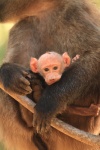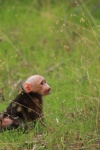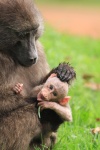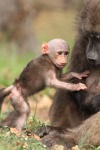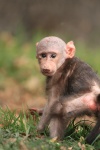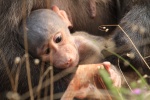Okay, I imagine everyone reading this also saw some mention of the American hunter (or huntress, as one commenter wrote, though that seems a little too Xena, Warrior Princess to me…) posed over the lion she shot in South Africa, which was undoubtedly followed by thousands of vitriolic comments you may have read that ranged from simply banning her from entering an entire country to wanting the woman’s head on a platter. This all because she did something that is, unfortunately, COMPLETELY LEGAL and then had the (some say) audacity to flaunt her prize. And, if I’ve read a lot of the comments correctly, because she happens to be a woman, it is apparently an even worse crime. ??? Bear with me here as I tackle all of this. I’m still trying to make sense of it all.
Here’s the rub about the whole situation – she didn’t actually do anything wrong, according to the law. And now anyone named ‘Melissa Bachman’, or any variation of that name, must hire armed guards and prove to the ravenous mobs of angry (and in a lot of cases misinformed or, worse, uninformed) posters that they are not, in fact, the ‘guilty party’ (who again, I must reiterate, is guilty of nothing but being a pompous ass with a large ego and misdirected sense of self).
Now I do not agree with trophy hunting. And I REALLY don’t agree with canned hunting, which, if I’m reading all the reports correct, is indeed what this woman’s hunt was. But the fact of the matter is, trophy hunting (even canned trophy hunting, which is conveniently called ‘captive hunting’ now) is legal in South Africa, as it is in many places in the world, including the United States. There are South Africans whose SOLE profession is as a professional hunter (or PH, as they are called here). There is a society dedicated to these people (http://www.phasa.co.za). Hunting is big business here. In fact, according to PHASA’s site, hunting tourists contributed R811 MILLION to the South African economy in 2012 alone. And most of the hunters who pay the money to hunt the game? They come from outside of the country (mostly the US and Europe). Now, whether the money ACTUALLY goes to conservation is another story, but the fact of the matter is, it does make money. And for many people, that’s all that matters.
PHs also hunt the wildlife many of these internet proselytizers so vehemently call for ‘protecting’. Yet it’s one woman people are directing their anger towards, not all these other hunters. This one woman, even if she got REALLY good at hunting, could still never do the amount of damage that South Africa does to itself when it comes to its wildlife. The same can be said of the US, and many other countries around the world. We hunt our own majestic animals, and then we rail against anyone with the nerve to do something we do ourselves. And we are okay keeping the cattle, chickens, and pigs we eat in miserable, miniature pens. Go figure.
I’d like to point out several facts that people should know before they continue on the witch hunt.
1. The same people who call for the ban of hunting are also often the people who want to visit the petting zoos so they can have a chance to cuddle a lion cub. And then this happens: http://www.mirror.co.uk/news/world-news/south-africa-lion-park-attack-5805070 And people then want to put all the blame on the lion. Why? Because it wasn’t tame? Because it did what lions do? There are signs all over that park telling visitors to keep their windows closed.
And as for the other lions in these types of places, the little cubs? What do you think happens to those lions when they grow up? You guessed it – they get used for canned hunts that bring in tens of thousands of dollars to the South African economy. So tourists ply money into the country via aggrandized petty zoos filled with adorable fuzzy predator kittens, and then other tourists come and shoot those kittens when they grow up. It’s a pretty sick cycle, but it is a cycle nonetheless, and if you want to hate on the hunting, don’t be the hypocritical idiot who goes to pet the baby lions. I know; I’m one. I had NO IDEA that this stuff happened. Now I do. And I will never do it again, nor will I encourage anyone else to do so. If you think I’m exaggerating, check out this article (http://www.lionaid.org/news/2013/11/the-furore-about-melissa-bachmans-lion-kill-in-south-africa-continues.htm) and spend some time on the LionAid website (www.LionAid.org). Africa Geographic did another article worth a read, if you feel like educating yourself even further (http://blog.africageographic.com/africa-geographic-blog/hunting/how-lions-go-from-the-petting-zoo-to-the-dinner-plate/).
Oh, and this current point goes for the place I used to work at as well, that abomination of an establishment that pretends it practices conservation, all the while abusing the wildlife it pretends to protect. I’m still debating about whether to just out the lodge, to be honest. Especially since now they have baby rhinos that they let guests pet. Yes, pet. You know, rhino? The critically endangered animals about to go extinct because of poaching? Yeah, they ACCLIMATE the animals to people. Makes it easier for a poacher to just walk up to one and shoot it, doesn’t it? Really great CONSERVATION work, isn’t it? Oh, and they charge serious ducats for the ‘privilege’ (with the rhino and with the cheetah) to interact with an animal they keep in captivity forever. But that’s another story for another day…back to the trophy hunting.
2. As I said, while the practice may not be nice, it is legal, and so was she. So instead of aiming your tomatoes (or daggers or abusive language or whatever else you choose to hurl) at her, aim them at the entire industry on the whole, and don’t restrict it to South Africa. If you hate trophy hunting and think it is a despicable practice, then take EVERY PLACE and EVERYONE associated with it to task, not ONE measly woman! She doesn’t deserve that much credit! Get pissed at the game farmers who raise animals to be shot for fun. For food, fine. For fun, not okay.
3. No one is actually doing anything but gossiping, for all intents and purposes. Get off your butts and do something. Instead of ‘Like’-ing a post from someone, create a petition that calls for the banning of trophy hunting. Get a few million people to sign it (if the petition in reaction to this Melissa chick is any indication, I’m sure you could get an actual USEFUL petition signed by even more people). Then get it out there. Contact places like the World Wildlife Fund, CITES, Panthera, and all the other conservation and/or lawmaking groups out there. Petition the governments of the countries. Make a difference, not a snide comment.
4. The conservation industry and the hunting industry are rather uncomfortable bed buddies. For a long time, the two have been intertwined, and many people believe that hunting HELPS conservation because it brings in money for the wildlife industry to pay for stuff like anti-poaching units and animal relocations. This causes serious issues, because people WITHIN conservation believe in trophy hunting as a fine and dandy practice. Not all of them, but some do. Also, it’s still up for debate as to where the funds actually go, but again, another story for another time.
And for a little lesson in conservation: the Kruger Park, one of the most beloved and beautiful places on earth, was STARTED as a hunting concession. The land was delegated as protected area so that game stocks could have a place to replenish. Because of uncontrolled hunting way back when, Paul Kruger and some friends decided that the best way to preserve the wildlife and restock the supplies of game was to set up a protected area for them. That way the animals could reproduce, gain in numbers, and then – drumroll, please – be HUNTED! Kruger, the epitome of conservation? Yup, that same Kruger. I kid you not, dear readers. So if you wonder why this topic is such a challenge, now maybe you’re starting to get a fuller picture of how difficult it is to separate the conservation industry from the hunting one. In the last two centuries, they grew up and developed together, those funny little animal-obsessed industries that they are.
5. From the myriad posts I saw, an awful lot of them were aimed at this woman more because she was a woman than because of what she did. This is something I find very interesting. Why is it that a female hunter is an abomination, but the gazillion male hunters who do this same thing every day don’t face the same vicious backlash? Wtf? Don’t be sexist about it. Choose to be either against something or for it, but don’t be a hypocrite who draws the line based on the machinery ‘down there’.
6. The other thing I noticed is that there was much less furor over other pictures on the internet of people killing other wildlife. Why is it that the lion gets so much attention, but the other animals – who are equally as important in the food chain – do not? Is it simply because the hunter is posed proudly next to her kill? There are plenty of those to be found online. What about people killing foxes in fox hunts, for instance?
Again, we can’t choose to champion one animal while we allow other animals to fall prey to more hunting simply because those other animals aren’t as ‘majestic’. Or we can, but we are once again proving to be hypocritical. And it’s very easy to poke holes in hypocrisy when you’re a lawmaker. Or a hunter. Or a poacher. Or a local desperate to feed his family. Or really anybody. It sort of ruins the foundation of your argument, you know? So by all means, protect lions. But protect hyenas as well, and vultures, and sharks, and…I don’t know…golden moles. You get the point.
7. It’s speculated this Ms. Bachman’s hunt was a captive, or canned, hunt. Canned hunts are perhaps the most shameful kind of hunt imaginable. They require pretty much no skill. I’m going to quote directly from the Born Free website here (www.bornfree.org.uk) to give you a better idea of what they entail: “Canned hunting, the hunting of wild animals in a confined area from which they cannot escape, is not only legal in South Africa, it is flourishing. Hunters from all over the world, but notably from the United States, Germany, Spain, France and the UK, flock to South Africa in their thousands and send home lion body parts, such as the head and skin, preserved by taxidermists, to show off their supposed prowess.
The animals involved are habituated to human contact, often hand-reared and bottle fed, so are no longer naturally fearful of people. Such animals will approach people expecting to get fed-but instead receive a bullet, or even an arrow from a hunting bow. This makes it easier for clients to be guaranteed a trophy and thus the industry is lucrative and popular.”
If you want to be nauseated a bit, check out the video of an actual canned hunt, courtesy of The Humane Society:
Another note about this? Lion parts are now being sold off to Asia to fuel the illegal wildlife trade, which then fuels demand, which then fuels poaching, etc. So yet another reason to not support the activity.
8. Many of the lodges here tout animal skins and heads as chic decor (the lion seems a very popular decorating item, in fact). It seems that to qualify as African decor, many a lodge feels the need to display pieces of dead animals all over its property. In fact, I’m sure if you did a little digging, you’d find some of those lodges online, with spectacular glamour shots of their animal-laden interiors. People still go to these places. And in many places, they pay stupid amounts of cash to go them. And that money is very rarely reinvested into the conservation industry (or the local community, for that matter). But you don’t see people ripping apart those lodges, their owners and their interior decorators, do you? You don’t see people boycotting them, or banning them from existence.
9. Most posts I’ve seen neglect the fact that the largest threat to animals overall is us. Not just hunting of the wildlife. Or over-loving it. Nope, it’s a simple numbers game. Our burgeoning and out-of-control population leaves little space for the rest of the animal kingdom to live. But no one seems ready to give up all the comforts they have to alleviate the situation. People just keep buying and wasting and expanding (in more ways than one). So again, I’m all for people getting aggro about this hunting situation and for taking notice of a situation that really is ugly. But unless you actively DO something about it, why bother getting mad? Why bother spending time firing verbal bullets at a woman who was doing what she had every right to do? Why not use the time to make a positive difference that matters? Volunteer, donate money, get off your butt to get laws changed, but for the love of all things wonderful in this world, please educate yourself before you start throwing lightening bolts at the next target. And walk the walk if you’re gonna talk the talk.
Okay, and with that, I’m off my soapbox. I know I have more points to make, but for now, maybe chew on that cud for a while. There’s a lot to digest, and plenty more where it came from.
Like I said, I don’t agree with trophy hunting. In fact, I don’t agree with hunting at all unless it’s for food, it’s fair game (meaning the animal can actually get away) and it’s legal. But I also don’t agree with this whole circus surrounding a woman who was, for better or for worse, within her rights. So if you have a problem with this practice, forget about the bimbo posing next to her kill. Go to https://www.change.org/petitions/stop-canned-hunting-in-south-africa and sign the petition to ban canned hunting in South Africa. And if you want to expand your banning to other locales, go for it! You can create your own petition on the website. It isn’t everything, but at least it’s a start. And it’s a start in the right direction.
I’d like to include some other links that would be good reading about the topic of mistreating wildlife, but rather than overwhelm you, I’ll focus on one specific post that I thought was quite interesting, given the fact that we seem to pick and choose how we like to interact with our wildlife.
Check out the newest venture of a Hilton Hotel in Hawaii, which is introducing sharks into its dolphin interaction lagoon. Dolphin interactions are also the antithesis of conservation, by the way. They do nothing good for the wildlife and a lot of good for the lining of the pockets of the people who force the wildlife to interact with humans. If this article doesn’t make you sit up and say, “Huh”, I don’t know what will…
http://www.huffingtonpost.com/2013/11/19/hawaii-hilton-sharks_n_4305392.html?ir=Travel





